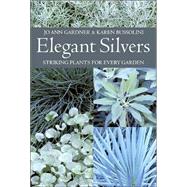
| A history of silvers | p. 15 |
| Sorting silvers | p. 35 |
| Designing with silvers | p. 51 |
| Encyclopedia of silvers from A to Z | p. 83 |
| Beautiful silvers for tough places | p. 271 |
| Where to see silvers | p. 276 |
| Table of Contents provided by Blackwell. All Rights Reserved. |
The New copy of this book will include any supplemental materials advertised. Please check the title of the book to determine if it should include any access cards, study guides, lab manuals, CDs, etc.
The Used, Rental and eBook copies of this book are not guaranteed to include any supplemental materials. Typically, only the book itself is included. This is true even if the title states it includes any access cards, study guides, lab manuals, CDs, etc.
Excerpted from Elegant Silvers: Striking Plants for Every Garden by Jo Ann Gardner, Karen Bussolini
All rights reserved by the original copyright owners. Excerpts are provided for display purposes only and may not be reproduced, reprinted or distributed without the written permission of the publisher.